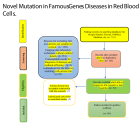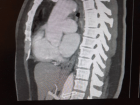Abstract
Research Article
Novel Mutation in Famous Gene Diseases in Red Blood Cells
Mahdi Nowroozi*
Published: 09 September, 2025 | Volume 9 - Issue 1 | Pages: 013-020
One of the most important and critical red blood cell disorders is dysfunction and deformation of the membrane structure, which affects the metabolic and biological red blood cell functions. On the other hand, the basic causes of these problems are the genetic mutations in the production of proteins that correlate to the structure and receptors of cells. The diagnosis methods and techniques are the other essential points that focus most scientists on. In this systematic review, the article pointed to the key title, which is the diagnosis of novel genes with different techniques and methods. The result of articles studies that were published in the last decades underlined the types of techniques such as Whole-Exome Sequencing, Quantitative Real-Time PCR, Targeted Next-Generation Sequencing, and Sulphate-Polyacrylamide Gel, which investigated the different membraned gene mutations that are novel and correlated to the genes that make the structures and functions of red blood cells such as hereditary spherocytosis, hereditary elliptocytosis, hereditary pyro poikilocytosis. In addition, the hereditary membrane disorders correlated to others, such as hereditary spherocytosis, have a relationship with vitamin B12, immunodeficiency.
Read Full Article HTML DOI: 10.29328/journal.niogb.1001023 Cite this Article Read Full Article PDF
Keywords:
Novel mutation; Red blood cell; Cytoskeletal; Laboratory diagnosis; Diseases
References
- Shih Y-H, Huang Y-C, Lin C-Y, Lin H-Y, Kuo S-F, Lin J-S, et al. A large family of hereditary spherocytosis and a rare case of hereditary elliptocytosis with a novel SPTA1 mutation underdiagnosed in Taiwan: A case report and literature review. Medicine (Baltimore). 2023;102(4):e32708. Available from: https://doi.org/10.1097/md.0000000000032708
- Donato H, Crisp RL, Rapetti MC, García E, Attie M. [Hereditary spherocytosis: Review. Part I. History, demographics, pathogenesis, and diagnosis]. Arch Argent Pediatr. 2015;113(1):69–80. Available from: https://bibliotecadigital.exactas.uba.ar/collection/paper/document/paper_03250075_v113_n1_p69_Donato
- Ma S, Deng X, Liao L, Deng Z, Qiu Y, Wei H, et al. Analysis of the causes of the misdiagnosis of hereditary spherocytosis. Oncol Rep. 2018;40(3):1451–8. Available from: https://doi.org/10.3892/or.2018.6578
- Maillet P, Alloisio N, Morlé L, Delaunay J. Spectrin mutations in hereditary elliptocytosis and hereditary spherocytosis. Hum Mutat. 1996;8(2):97–107. Available from: https://doi.org/10.1002/(sici)1098-1004(1996)8:2%3C97::aid-humu1%3E3.0.co;2-m
- Niss O, Chonat S, Dagaonkar N, Almansoori MO, Kerr K, Rogers ZR, et al. Genotype-phenotype correlations in hereditary elliptocytosis and hereditary pyropoikilocytosis. Blood Cells Mol Dis. 2016;61:4–9. Available from: https://doi.org/10.1016/j.bcmd.2016.07.003
- Da Costa L, Galimand J, Fenneteau O, Mohandas N. Hereditary spherocytosis, elliptocytosis, and other red cell membrane disorders. Blood Rev. 2013;27(4):167–78. Available from: https://doi.org/10.1016/j.blre.2013.04.003
- Panarach C, Netsawang C, Nuchprayoon I, Leecharoenkiat K. Identification and functional analysis of novel SPTB and ANK1 mutations in hereditary spherocytosis patients. Sci Rep. 2024;14(1):27362. Available from: https://doi.org/10.1038/s41598-024-78622-w
- Kalfa TA. Diagnosis and clinical management of red cell membrane disorders. Hematology Am Soc Hematol Educ Program. 2021;2021(1):331–40. Available from: https://doi.org/10.1182/hematology.2021000265
- Agarwal AM, Nussenzveig RH, Reading NS, Patel JL, Sangle N, Salama ME, et al. Clinical utility of next-generation sequencing in the diagnosis of hereditary haemolytic anaemias. Br J Haematol. 2016;174(5):806–14. Available from: https://doi.org/10.1111/bjh.14131
- Boaro MP, Reggiani G, D’Agnolo M, Munaretto V, Pozzebon F, Trapanese R, et al. Hematological characteristics and hepatobiliary complications of hereditary spherocytosis in a tertiary care pediatric center: optimizing diagnosis and care through local and international networks. Front Pediatr. 2023;11. Available from: https://doi.org/10.3389/fped.2023.1269645
- Bolton-Maggs P, Langer J, Iolascon A, Tittensor P, King M-J. Guidelines for the diagnosis and management of hereditary spherocytosis—2011 update. Br J Haematol. 2011;156:37–49. Available from: https://doi.org/10.1111/j.1365-2141.2011.08921.x
- Glenthøj A, Brieghel C, Nardo-Marino A, van Wijk R, Birgens H, Petersen J. Facilitating EMA binding test performance using fluorescent beads combined with next-generation sequencing. EJHaem. 2021;2(4):716–28. Available from: https://doi.org/10.1002/jha2.277
- Chonat S, Risinger M, Sakthivel H, Niss O, Rothman JA, Hsieh L, et al. The spectrum of SPTA1-associated hereditary spherocytosis. Front Physiol. 2019;10:815. Available from: https://doi.org/10.3389/fphys.2019.00815
- Palek J. Hereditary elliptocytosis, spherocytosis and related disorders: consequences of a deficiency or a mutation of membrane skeletal proteins. Blood Rev. 1987;1(3):147–68. Available from: https://doi.org/10.1016/0268-960x(87)90031-2
- Wu Y, Liao L, Lin F. The diagnostic protocol for hereditary spherocytosis—2021 update. J Clin Lab Anal. 2021;35(12):e24034. Available from: https://doi.org/10.1002/jcla.24034
- Sarmah P, Ghanashyam C, Khanna R, Bankapur A. Unraveling biochemical differences in the membrane of functional RBCs and elliptocytes using vortex beam-based micro-Raman spectroscopy. Spectrochim Acta A Mol Biomol Spectrosc. 2025;334:125911. Available from: https://doi.org/10.1016/j.saa.2025.125911
- Gerber GF. Hereditary spherocytosis and hereditary elliptocytosis. MSD Manual Professional Edition: MSD Manual; 2024 [updated 2024 Apr]. Available from: https://www.msdmanuals.com/professional/hematology-and-oncology/anemias-caused-by-hemolysis/hereditary-spherocytosis-and-hereditary-elliptocytosis
- Ittiwut C, Natesirinilkul R, Tongprasert F, Sathitsamitphong L, Choed-Amphai C, Fanhchaksai K, et al. Novel mutations in SPTA1 and SPTB identified by whole exome sequencing in eight Thai families with hereditary pyropoikilocytosis presenting with severe fetal and neonatal anaemia. Br J Haematol. 2019;185(3):578–82. Available from: https://doi.org/10.1111/bjh.15559
- Dhermy D, Schrével J, Lecomte MC. Spectrin-based skeleton in red blood cells and malaria. Curr Opin Hematol. 2007;14(3):198–202. Available from: https://doi.org/10.1097/moh.0b013e3280d21afd
- Da Costa L, Galimand J, Fenneteau O, Mohandas N. Hereditary spherocytosis, elliptocytosis, and other red cell membrane disorders. Blood Rev. 2013;27(4):167–78. Available from: https://doi.org/10.1016/j.blre.2013.04.003
- Anil More T, Kedar P. Unravelling the genetic and phenotypic heterogeneity of SPTA1 gene variants in hereditary elliptocytosis and hereditary pyropoikilocytosis patients using next-generation sequencing. Gene. 2022;843:146796. Available from: https://doi.org/10.1016/j.gene.2022.146796
- Brancamp R, Hughes CE, Dar A, Polic A, Zuckerwise LC, Booth GS. Homozygous SPTA1-associated hereditary pyropoikilocytosis presenting as hydrops fetalis. Transfusion. 2024;64(1):189–93. Available from: https://doi.org/10.1111/trf.17617
- Gallagher PG. Hereditary elliptocytosis: spectrin and protein 4.1R. Semin Hematol. 2004;41(2):142–64. Available from: https://doi.org/10.1053/j.seminhematol.2004.01.003
- Andolfo I, Russo R, Gambale A, Iolascon A. Hereditary stomatocytosis: An underdiagnosed condition. Am J Hematol. 2018;93(1):107–21. Available from: https://doi.org/10.1002/ajh.24929
- Wallace MD, Falcone S, Castillo D, Williams TL, Davison LJ. Whole genome sequencing identifies novel candidate genetic variants in canine stomatocytosis. Gene. 2025;945:149314. Available from: https://doi.org/10.1016/j.gene.2025.149314
- Andolfo I, Martone S, Rosato BE, Marra R, Gambale A, Forni GL, et al. Complex modes of inheritance in hereditary red blood cell disorders: A case series study of 155 patients. Genes (Basel). 2021;12(7). Available from: https://doi.org/10.3390/genes12070958
- World Health Organization. Classification of Glucose-6-phosphate dehydrogenase (G6PD). Geneva (Switzerland): WHO Tctr.
- Liu Y, Jin S, Li Y, Xu R, Pang W, Wang K, et al. Treatment of asymptomatic gallstones in children with hereditary spherocytosis requiring splenectomy. J Pediatr Surg. 2023;58(4):756–61. Available from: https://doi.org/10.1016/j.jpedsurg.2022.11.012
- Bhargavi S, Jeniffer VN, Ramu SA. Hereditary spherocytosis with preserved eosin-5-maleimide binding. Karnataka Paediatr J. 2025;40(1):29–31. Available from: https://iap-kpj.org/content/113/2025/40/1/pdf/KPJ-40-029.pdf
- Turpaev K, Bovt E, Shakhidzhanov S, Sinauridze E, Smetanina N, Koleva L, et al. An overview of hereditary spherocytosis and the curative effects of splenectomy. Front Physiol. 2025;16:1497588. Available from: https://doi.org/10.3389/fphys.2025.1497588
- Sahile Kebede S, Aregawi Y, Tesfaye Y, Getachew MB, Tadesse D, Woldu B. The magnitude of hereditary spherocytosis among human immunodeficiency virus-infected adults attending University of Gondar Comprehensive Specialized Hospital, Northwest Ethiopia, 2021 GC: cross-sectional study design. Pathol Lab Med Int. 2022;14:15–23. Available from: https://doi.org/10.2147/PLMI.S366451
- Seedat F, Patel M, Waja F, Sigauke FR, Variava E. Hereditary spherocytosis and human immunodeficiency virus (HIV) infection: is there an association? Hematol Leuk. 2015;3:3. Available from: http://dx.doi.org/10.7243/2052-434X-3-3
- Aemro A, Workneh BS, Mekonen EG, Wassie M, Chekol B. Prevalence of anaemia and its associated factors among HIV-infected adults at the time of ART initiation at Debre Markos Comprehensive Specialized Hospital, Northwest Ethiopia: A retrospective cross-sectional study. BMJ Open. 2022;12(6):e057235. Available from: https://doi.org/10.1136/bmjopen-2021-057235
- Li X, Zhang T, Li X, Wang L, Li Q, Liu Q, et al. Identification of a novel SPTB gene splicing mutation in hereditary spherocytosis: A case report and diagnostic insights. Front Genet. 2025;15. Available from: https://www.frontiersin.org/journals/genetics/articles/10.3389/fgene.2024.1522204/full
- Jha SK. VSHEUFISITIFSPJ-Afh.
- Lichtman MA, Sham R. Acquired elliptocytosis in chronic myeloid neoplasms: An enigmatic relationship to acquired red cell membrane protein and genetic abnormalities. Blood Cells Mol Dis. 2023;103:102778. Available from: https://doi.org/10.1016/j.bcmd.2023.102778
- Brancamp R, Hughes C, Dar A, Polic A, Zuckerwise L, Booth G. Homozygous SPTA1-associated hereditary pyropoikilocytosis presenting as hydrops fetalis. Transfusion. 2023;64:189–93. Available from: https://doi.org/10.1111/trf.17617
- Bolton-Maggs PH. Hereditary spherocytosis: new guidelines. Arch Dis Child. 2004;89(9):809–12. Available from: https://doi.org/10.1136/adc.2003.034587
- Polizzi A, Dicembre L, Failla C, Matola TD, Moretti M, Ranieri SC, et al. Overview of hereditary spherocytosis diagnosis. Int J Lab Hematol. 2025;47(1):18–25. Available from: https://doi.org/10.1111/ijlh.14376
- Wu Y, Liao L, Lin F. The diagnostic protocol for hereditary spherocytosis—2021 update. J Clin Lab Anal. 2021;35(12):e24034. Available from: https://doi.org/10.1002/jcla.24034
- Häuser F, Rossmann H, Adenaeuer A, Shrestha A, Marandiuc D, Paret C, et al. Hereditary spherocytosis: Can next-generation sequencing of the five most frequently affected genes replace time-consuming functional investigations? Int J Mol Sci. 2023;24(23). Available from: https://doi.org/10.3390/ijms242317021
- Blecher TE. What happens to the microspherocytosis of hereditary spherocytosis in folate deficiency? Clin Lab Haematol. 1988;10(4):403–8. Available from: https://doi.org/10.1111/j.1365-2257.1988.tb01188.x
Figures:

Figure 1

Figure 2
Similar Articles
-
The interaction between photonic technology and physical exercise: The action of low-level laser therapyAntonio Eduardo de Aquino Jr*,Fernanda Mansano Carbinatto. The interaction between photonic technology and physical exercise: The action of low-level laser therapy. . 2017 doi: 10.29328/journal.hodms.1001003; 1: 010-013
-
Dietary and Lifestyles assessment among Obese Women in Gaza City, PalestineMarwan O Jalambo*,Basil Kanoa,Mohammed S Ellulu,Smaher Younis,Mueen El-Kariri. Dietary and Lifestyles assessment among Obese Women in Gaza City, Palestine. . 2018 doi: 10.29328/journal.niogb.1001009; 2: 017-025
-
ECHO…for a change!!Manish Motwani*,Rajeev Palvia,Bhavesh Nanda,Mahek Motwani,Bhakti Chaubal,Jyoti Kesarkar, Bhakti Mange,Sneha Shukla. ECHO…for a change!!. . 2020 doi: 10.29328/journal.niogb.1001011; 4: 001-003
-
Novel Mutation in Famous Gene Diseases in Red Blood CellsMahdi Nowroozi*. Novel Mutation in Famous Gene Diseases in Red Blood Cells. . 2025 doi: 10.29328/journal.niogb.1001023; 9: 013-020
Recently Viewed
-
Pulmonary Infarction Mimicking An Aspergilloma In A Heart Transplant RecipientAntonacci F*,Belliato M,Bortolotto C,Di Perna D,Dore R,Orlandoni G,D’Armini AM. Pulmonary Infarction Mimicking An Aspergilloma In A Heart Transplant Recipient . J Clin Med Exp Images. 2017: doi: 10.29328/journal.jcmei.1001002; 1: 005-006
-
Recurrent Peripheral Ameloblastoma of the Mandible: A Case ReportAngela Jordão Camargo*,Mayara Cheade,Celso Martinelli,Plauto Christopher Aranha Watanabe. Recurrent Peripheral Ameloblastoma of the Mandible: A Case Report. J Clin Med Exp Images. 2017: doi: 10.29328/journal.jcmei.1001003; 1: 007-010
-
The Risk Factors for Ankle Sprain in Cadets at a Male Military School in Iran: A Retrospective Case-control StudyFarzad Najafipour*,Farshad Najafipour,Mohammad Hassan Majlesi,Milad Darejeh. The Risk Factors for Ankle Sprain in Cadets at a Male Military School in Iran: A Retrospective Case-control Study. J Clin Med Exp Images. 2017: doi: 10.29328/journal.jcmei.1001005; 1: 020-026
-
Magnetic Resonance Imaging Can Detect Symptomatic Patients with Facet Joint Pain. A Retrospective AnalysisWolfgang Freund*,Frank Weber,Reinhard Meier,Stephan Klessinger. Magnetic Resonance Imaging Can Detect Symptomatic Patients with Facet Joint Pain. A Retrospective Analysis. J Clin Med Exp Images. 2017: doi: 10.29328/journal.jcmei.1001006; 1: 027-036
-
Secondary Onychomycosis Development after Cosmetic Procedure-Case ReportMariusz Dyląg*,Emilia Flisowska,Patryk Bielecki,Maria Kozioł-Gałczyńska,Weronika Jasińska. Secondary Onychomycosis Development after Cosmetic Procedure-Case Report . J Clin Med Exp Images. 2017: doi: 10.29328/journal.jcmei.1001007; 1: 037-045
Most Viewed
-
Impact of Latex Sensitization on Asthma and Rhinitis Progression: A Study at Abidjan-Cocody University Hospital - Côte d’Ivoire (Progression of Asthma and Rhinitis related to Latex Sensitization)Dasse Sery Romuald*, KL Siransy, N Koffi, RO Yeboah, EK Nguessan, HA Adou, VP Goran-Kouacou, AU Assi, JY Seri, S Moussa, D Oura, CL Memel, H Koya, E Atoukoula. Impact of Latex Sensitization on Asthma and Rhinitis Progression: A Study at Abidjan-Cocody University Hospital - Côte d’Ivoire (Progression of Asthma and Rhinitis related to Latex Sensitization). Arch Asthma Allergy Immunol. 2024 doi: 10.29328/journal.aaai.1001035; 8: 007-012
-
Causal Link between Human Blood Metabolites and Asthma: An Investigation Using Mendelian RandomizationYong-Qing Zhu, Xiao-Yan Meng, Jing-Hua Yang*. Causal Link between Human Blood Metabolites and Asthma: An Investigation Using Mendelian Randomization. Arch Asthma Allergy Immunol. 2023 doi: 10.29328/journal.aaai.1001032; 7: 012-022
-
An algorithm to safely manage oral food challenge in an office-based setting for children with multiple food allergiesNathalie Cottel,Aïcha Dieme,Véronique Orcel,Yannick Chantran,Mélisande Bourgoin-Heck,Jocelyne Just. An algorithm to safely manage oral food challenge in an office-based setting for children with multiple food allergies. Arch Asthma Allergy Immunol. 2021 doi: 10.29328/journal.aaai.1001027; 5: 030-037
-
Snow white: an allergic girl?Oreste Vittore Brenna*. Snow white: an allergic girl?. Arch Asthma Allergy Immunol. 2022 doi: 10.29328/journal.aaai.1001029; 6: 001-002
-
Cytokine intoxication as a model of cell apoptosis and predict of schizophrenia - like affective disordersElena Viktorovna Drozdova*. Cytokine intoxication as a model of cell apoptosis and predict of schizophrenia - like affective disorders. Arch Asthma Allergy Immunol. 2021 doi: 10.29328/journal.aaai.1001028; 5: 038-040

If you are already a member of our network and need to keep track of any developments regarding a question you have already submitted, click "take me to my Query."















































































































































